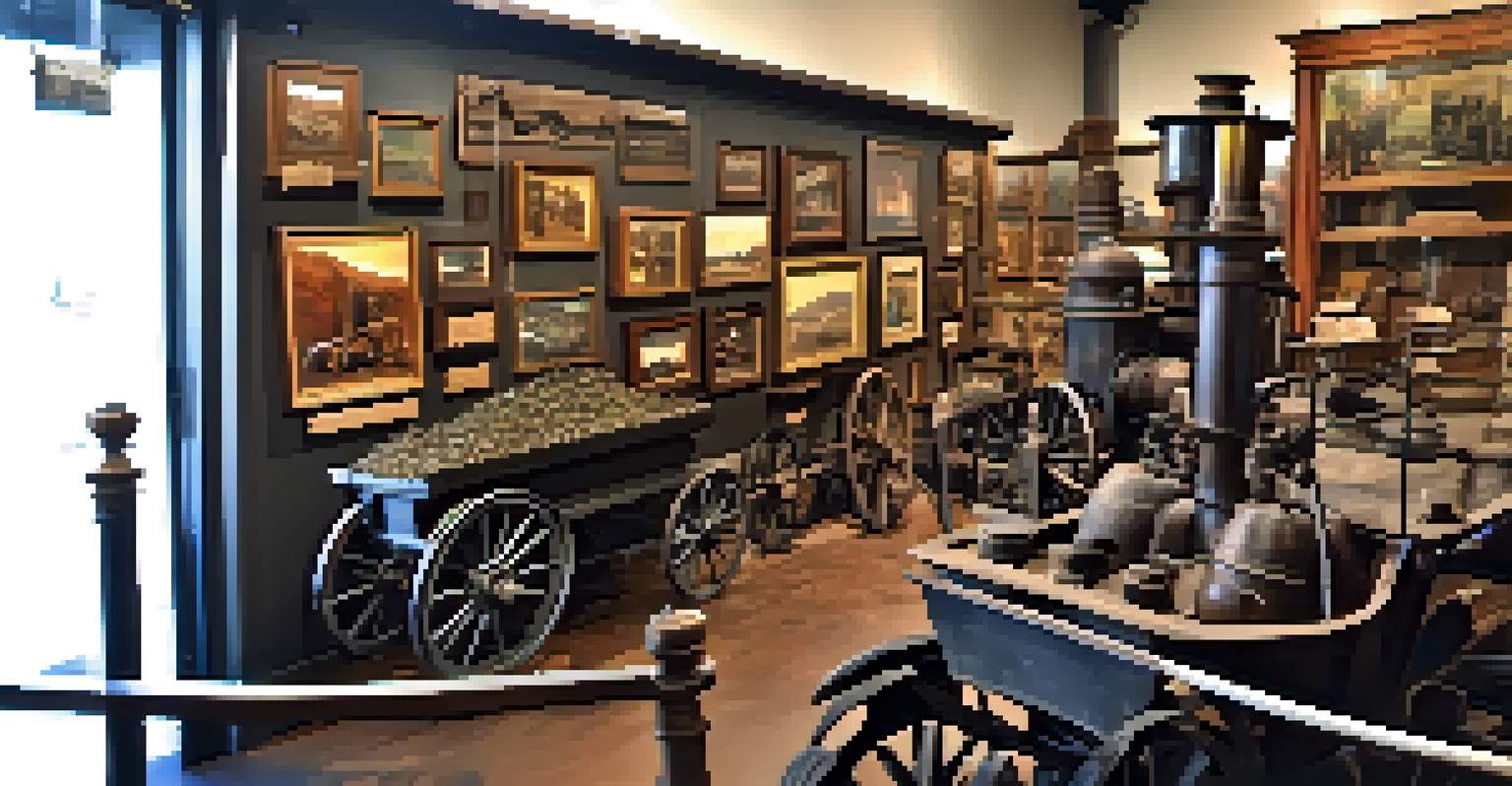Mining Heritage in Nevada: A Journey Through History and Culture

An Overview of Nevada's Mining History
Nevada's mining history dates back to the mid-19th century, when the discovery of silver in the Comstock Lode transformed the region. This boom attracted thousands of prospectors, leading to the establishment of towns and infrastructure that still influence Nevada's culture today. Mining not only shaped the economy but also contributed to the diverse tapestry of communities across the state.
Mining is a vital part of Nevada's identity, influencing not just the economy but also the cultural landscape.
As mining expanded, so did its impact on the landscape and society. The influx of miners brought together people from various backgrounds, creating a melting pot of cultures. This blend of traditions can still be felt in Nevada's festivals, food, and local customs.
Today, remnants of this rich history can be seen in ghost towns, museums, and preserved mining sites that tell the stories of those who came in search of fortune. Understanding this history offers a deeper appreciation of Nevada's identity and the resilience of its people.
The Comstock Lode: A Turning Point in Mining
The Comstock Lode, discovered in 1859, was pivotal in Nevada's mining narrative, marking the first major silver discovery in the United States. This massive silver vein not only fueled the economy but also led to the rapid growth of cities like Virginia City, which became a bustling hub of commerce and culture. The wealth generated from the Comstock significantly contributed to the funding of the Civil War and the development of the Western United States.

Within a decade, Virginia City was home to a diverse population of miners, merchants, and entrepreneurs. This dynamic environment fostered a unique culture characterized by a mix of ambition, risk-taking, and community spirit. Stories of success and failure in the mining industry became legendary, shaping the folklore of Nevada.
Mining Shapes Nevada's Identity
Nevada's mining history has profoundly influenced its economy, culture, and community dynamics.
Today, Virginia City stands as a living museum, where visitors can explore its historic streets, learn about mining techniques, and experience the vibrant culture that thrived during the boom. The Comstock Lode's legacy continues to influence Nevada's identity, drawing tourists eager to connect with this fascinating past.
Mining's Role in Shaping Nevada's Economy
Mining has been a cornerstone of Nevada's economy for over a century, with gold, silver, and more recently, lithium, driving economic growth. The boom-and-bust nature of mining has created cycles of prosperity and hardship, but it has also fostered innovation and adaptability among Nevadans. Communities evolved, diversifying their economies while still honoring their mining roots.
The stories of success and failure in the mining industry became legendary, shaping the folklore of Nevada.
As the demand for minerals rose with technological advancements, Nevada became a leading producer, particularly in gold mining. The discovery of new mineral deposits led to the establishment of modern mining operations, which continue to provide jobs and stimulate local economies. This ongoing relationship with mining is a testament to the resilience and resourcefulness of the state's inhabitants.
Furthermore, the mining industry has spurred the growth of related sectors, including tourism, manufacturing, and transportation. Today, mining remains an integral part of Nevada's identity, influencing not just the economy but also the cultural landscape, from art to education.
Cultural Heritage: Festivals and Traditions
Nevada's mining heritage is celebrated through various festivals and traditions that pay homage to the state's rich history. Events like the Virginia City International Camel Races and the Gold Rush Days highlight the adventurous spirit of the miners and their families. These celebrations bring communities together, fostering a sense of pride and belonging.
Local cuisine, influenced by the diverse backgrounds of miners, showcases dishes that reflect this cultural fusion. From hearty cowboy fare to dishes inspired by immigrants who settled in mining towns, Nevada's food scene is a delicious testament to its mining heritage. Visitors can experience this culture through food festivals and local eateries, making every meal a historical journey.
Comstock Lode Drives Economic Growth
The discovery of the Comstock Lode in 1859 catalyzed the rapid development of towns like Virginia City, significantly impacting the state's financial landscape.
Moreover, storytelling plays a vital role in preserving mining history. Oral histories and folk tales shared by local residents keep the legacy alive, allowing younger generations to connect with their roots. These narratives contribute to Nevada's unique character, blending the past with the present in a vibrant cultural tapestry.
Ghost Towns: Windows to the Past
Nevada is home to numerous ghost towns, remnants of the mining boom that once thrived in the arid landscape. These abandoned sites, like Rhyolite and Goldfield, tell powerful stories of ambition, struggle, and the transience of fortune. Exploring these towns offers a glimpse into the lives of those who sought wealth and adventure in the unforgiving terrain.
Each ghost town has its own unique history, often marked by the rise and fall of mining operations. Visitors can wander through crumbling buildings, rusted machinery, and remnants of daily life, sparking the imagination about what life was like during the heyday of mining. Guided tours and interpretive signs help bring these stories to life, connecting visitors with Nevada's past.
These sites serve not only as tourist attractions but also as reminders of the resilience of those who lived there. The stories of triumph and hardship that unfolded in these towns are essential to understanding Nevada's mining heritage and its lasting impact on the state's culture.
Museums and Educational Resources
Nevada boasts several museums dedicated to preserving its mining heritage, offering educational resources for visitors of all ages. The Nevada State Museum in Carson City features exhibits on mining history, showcasing artifacts, photographs, and interactive displays that bring the past to life. These institutions play a crucial role in educating the public about the significance of mining in shaping the state.
In addition to traditional museums, many mining sites have been transformed into educational experiences. Places like the Tonopah Mining Park allow visitors to explore old mines and learn about the techniques used by miners. This hands-on approach not only engages visitors but also fosters a deeper appreciation for the challenges faced by those who worked in the mining industry.
Cultural Celebrations Honor Heritage
Festivals and local traditions in Nevada celebrate the state's mining heritage, fostering community pride and preserving historical narratives.
Workshops and lectures are often held at these venues, providing opportunities for community engagement and further learning. By promoting an understanding of mining heritage, these educational resources help ensure that the stories of Nevada's past continue to be told and celebrated.
The Future of Mining Heritage in Nevada
As Nevada continues to evolve, the future of its mining heritage remains a topic of discussion and preservation. With increasing interest in sustainable mining practices and environmental considerations, the industry faces new challenges. Balancing economic growth with responsible stewardship of natural resources will be crucial for future generations.
Community initiatives aimed at preserving mining history are gaining momentum, with local organizations working to restore historic sites and promote awareness. These efforts not only protect the past but also engage younger generations in understanding their cultural heritage. By fostering a sense of pride in Nevada's mining history, communities can create a sustainable future.

Ultimately, the legacy of mining in Nevada will continue to influence its culture, economy, and identity. By celebrating and preserving this heritage, the state can ensure that the stories of miners and their contributions remain an integral part of Nevada's narrative for years to come.